In a previous blog I wrote about the differences between dance, karana and tandava. I took up the subject because a good friend, Shashi Kolar, raised this question in a Facebook discussion. Dance has been a lifelong passion for me. As a Bharata Natyam dancer and a Nataraja bhakta this question has also always drawn my personal attention. In this blog I will illustrate my argument with the specific example of Gangavatarana Karana and Gangavatarana Tandava. My argument is that we can distinguish three ‘levels’ of dance represented in South Indian (temple) art. These are
(1) dance depicted from the living contemporary tradition of the time of the sculptor.
(2) karanas depicted as illustrating the Natya Shastra.
(3) Shiva’s Tandava, or divine dance as representing spiritual concepts. And that it is sensible to realise the differences and commonalities between the three.
Karana
A karana is a technical term used by Bharata Muni in his Natya Shastra to indicate the 108 dance movements that make up the nritta or abstract aspect of the three-fold art of drama. (1) Natya is the dramatical content, (2) nritya is dance which conveys a story, (3) nritta is abstract dance. This nritta aspect of the art of drama was introduced by Shiva. He was inspired by the first performance of a drama on mount Kailasha to add abstract dance to this new art form. He instructed Tandu to teach the 108 karanas to Bharata Muni. These 108 karanas represent a vigorous, masculine form of dance which was called tandava. The 108 movements were inspired by or based on Shiva’s own divine dance called Sandhya Tandava or twilight dance. Which Shiva performs daily on Mount Kailasha as the sun sets for the day.
Tandava
Generally all Shiva’s various dances are called Tandava. It means “dancing, especially with violent gesticulation, and particularly applied to the frantic dance of the god Siva”. There are various lists or divisions. Some well known Tandavas are the Ananda Tandava, Urdhva Tandava, Sandya Tandava [find your lists] We often see a mixed-up use of tandava and karana. The consequence of the terms being used indiscriminately as general words or as technical terms. This is not unusual in archaic texts. The ancients had a very clear understanding of what they were doing, but were not as obsessed with definitions as we are. This easily leads to confusion in understanding and definition. Let me give an example to clarify.
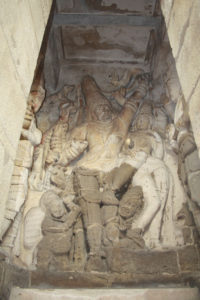
Gangavatarana in the puranas
Gangavatarana is a well known term from mythology and iconography. It means “Descend of Ganga” and generally refers to a well know puranic episode in the Shaiva tradition. Ganga was a heavenly river. She was brought down to earth through the tapas of Bhagirata, who needed her water to perform the last rites for the ashes of his ancestors. As she was flowing down from heaven it was realised the force of her descend would destroy the earth. Shiva stepped in and received her in his jata, his ascetics’ locks. Diverting the force of the falling water till it would be safe to flow down. It is said his locks are the trees on Himalaya mountains. Cutting the trees releases the force of the waters, creating erosion and eventually flooding and disasters.
Mother Parvati was very unhappy with her husband’s attention to this ‘other woman’. Shiva had to convince her. The scene is a favourite one with the ancient sculptors.
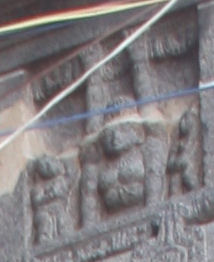
Gangavatarana Karana (108)
Gangavatarana is also the name of the last of the series of 108 abstract dance movements described in Bharata Muni’s Natya Shastra. Karana number 108 is defined as follows
Gangavatarana:
ūrdhvāṅgulitalaḥ pādastripatākāvadhomukhau |
hastau śirassannataṃ ca gaṅgāvataraṇaṃ tviti ||
In the Tandava Lakshanam this is translated as: the feet with the heels turned up with the toes, the hands in tripataka facing downwards, and the head in sannata constitute this karana.
Manmohan Gosh translates: foot with the toes and the sole turned upwards, hands showing Tripataka with the fingers pointing downwards and the head being Sannata.
The karanas are systematically illustrated in five south Indian temples. Two examples from these five are given with this article. The first is from the East gopuram of the Nataraja temple in Chidambaram. The second is from the gopuram of the Sarangapani temple in Kumbakonam.
In the relief from Chidambaram we see the dancer balancing on both her hands with arms straight. Legs up and behind her, slightly bended, with the soles of the feet showing. As this relief is high up on the wall we can’t see her hands. Which should be in tripataka (three parts of the flag), a hasta (hand gesture) in which all the fingers and thumb are held flat and close together with the ringfinger bend at the first digit.
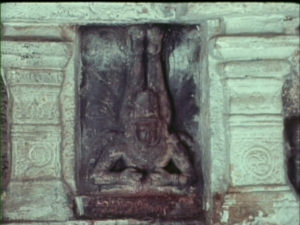
The panel from Kumbakonam shows the dancer balancing on her underarms. As a dancer I find the use of the tripataka hasta here mystifying. To balance on one’s hands with the ring finger bended makes no sense from a physical point of view. The Kumbakonam versions makes a little more sense. Still it raises many questions about the karanas and the reliefs depicting them. I hope to address these in future some time.
Gangavataran
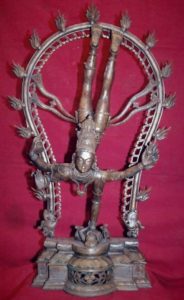
a Tandava
The word tandava is used as meaning vigorous masculine dance in general in the Natya Shastra. But it is also used as a term signifying Shiva’s various dance manifestations as in Ananda Tandava, Urdhva Tandava, Sandhya Tandava, Gauri Tandava etc. From literary sources I have found lists of seven, twelve and sixteen Tandavas.
From time to time I have come across illustrations of bronzes which depict Shiva as Gangavatarana Tandava. The illustration here was shared on facebook. I know another one from a publication on the data base of the Institute Français in Pondicherry, “Shadows of Gods: an archive and its images“. It was illustrated on Twitter (https://twitter.com/maharajadhiraj). The first time I came across this was as the frontispiece to a publication on Indian dance. It is a rare depiction one of Shiva’s rare Tandavas.
Because it is rare people often assume it must be a recent concept. Something made out of modern fancy or for the tourist industry. This is not so. The first time I saw it was as the frontispiece of this book on Indian dance. Alas I can’t give the reference now. Anyway this was a publication from 30 years ago. Raja Deekshithar told me it was one of His Tandava’s. rarely found under worship. Somehow I remember he said it belonged more to the Andhra region than to Tamil Nadu. He told more about it, but it was a casual conversation and I don’t remember what else he shared. His eldest son, Kandhan Raja Deekshithar, has been trying to see if our small personal library has more information to offer. So far nothing has come up that would give more clarity.
You can see the pose is very similar to the karana, but it differs in several significant points. Which distinguishes it as one of Shiva’s Tandavas. And different in a significant degree from the karana with the same name. It is also very different from the well known reliefs depicting the Gangavatarana mythological episode.
Shiva’s Tandava
The four armed Shiva is balancing himself with the lower one of his two left hands. This hand is resting on the apasmara which is lying on its back The other hands are in Abhaya Hasta and holding the damaru and the fire. Which are the well known attributes of Shiva’s Ananda Tandava. Shiva’s feet are up in the air, slightly bended at the knees. The figure is surrounded by the prabha, the oval of flames. Through the name this form of Tandava is directly connected to the Descend of Ganga episode. Through the form it is partially connected to the 108th karana. This generates confusion and the assumption it must be somehow a modern concept. I understood it is connected with some local tradition, probably from somewhere in the Andhra region.
My thoughts
I am not sure of the exact spiritual concept expressed through this Tandava. There is probably some connection to the whole Descend of Ganga episode. But it could be a very different idea also. Usually Gangavatarana is understood as the descend of heavenly river, represented as a beautiful woman, becoming a second wife to Shiva. Causing Parvati to be jealous. Here we see Shiva himself descending, as it were.
I will keep looking for the origin and background of this beautiful and mysterious Tandava.
Thank you for your attention
PS. this is a link to the original FB discussion
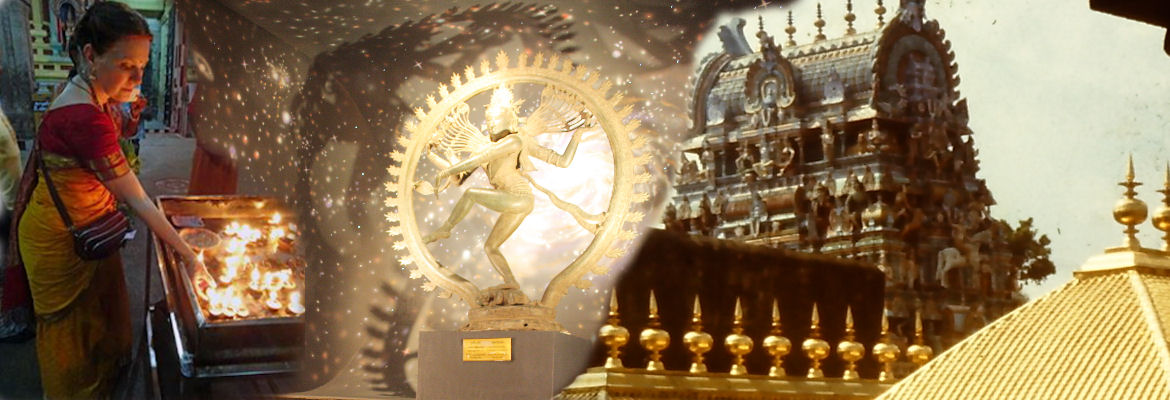
M. Rengarajan
Very good explanation and facts about flying Posture of Lord Shiva
Mahesh Uday Patil
It’s a 2 step process.
1. Ganga getting locked in jata (space )for few years before it was released on earth. This action is delicately handled in cosmic context
2.it was released on earth in 7 parts(dharas) which impacted earth with destructive force. This impact was violant thus ancient scholars would compare this with Tandav
Kiraun
Thank you for the insight. Since many things in India does out as Diksha in verbal form written explanations are rare and hence difficult to find the documents. Thank you once again. Regards
VARALAKSHMI VENKATRAMAN
Miga miga arumai. Love it. Excellent posture of BELOVED EM IYYAN SIVAN. OM NAMA SIVAYA!!